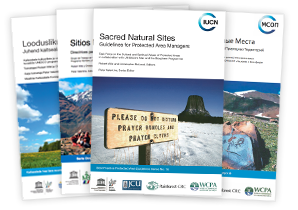
Protected area managers, planners, local people and custodians in Portuguese speaking countries can now explore the Essential IUCN UNESCO Guidelines “Sacred Natural Sites, Guidelines for Protected Area Managers” in Portuguese.
The Guidelines have been generously translated by professional translator Ms. Bruna Katletz from Brazil. “It’s hard to read and work on this subject without being touched by the cause…. …Brazil is a vast country, facing a huge ecological and social crises, where biodiversity and natural resources are being threatened.” Said Ms. Kadletz. Ms. Kadletz also translated the IUCN Resolution, the Sacred Natural sites Action Plan and a Custodian Statement into Portuguese.
Sítios Naturais Sagrados, Normativas para Gerenciamento das Áreas Protegidas. Princípios e Normativas para o Gerenciamento dos Sítios Naturais Sagrados Localizados em Áreas Protegidas Reconhecidas Legalmente.
The Guidelines Translation Project is a project that has supported the translation the IUCN UNESCO Guidelines into seven languages. The “Essential Guidelines” that consist of six principles and 44 guidelines cover only 5 pages and have been translated into an additional 3 languages. They can be seen as a quick guide or an essential guide to improving recognition and management of sacred natural sites in and adjacent to protected areas.
 The purpose of the translations is to make the guidelines available in local languages so that they can be of use to local protected area managers and indigenous peoples. “Whilst translations help to get the word out across the worlds rich linguistic diversity, most of the time the initiative to translate the guidelines comes from protected area agencies and local organisations themselves” said Mr. Robert Wild, Co-Editor of the Guidelines.
The purpose of the translations is to make the guidelines available in local languages so that they can be of use to local protected area managers and indigenous peoples. “Whilst translations help to get the word out across the worlds rich linguistic diversity, most of the time the initiative to translate the guidelines comes from protected area agencies and local organisations themselves” said Mr. Robert Wild, Co-Editor of the Guidelines.
Japan is a case in point and a such is paving setting an example for Portuguese speaking countries such as Brazil. Last year the Japanese division of the World Commission of Protected Areas (WCPA-J) presented the Japanese translation at the CBD COP11. This WCPA-J has joined forces with the Sacred Natural Sites Initiative and together they will be supporting a programme to improve the recognition of sacred natural sites in protected areas in Asia. In doing so the project is specifically looking at the implementation and potential application of the guidelines in Japan and the Asian region at large. A session at the first Asian Parks Congress will be dedicated to this.
It is great to see that the Guidelines are being picked up by protected area managers and indigenous peoples, this clearly signals that there is a need for these places to better looked after and protected. This need is also apparent in Portuguese speaking countries such as Brazil and Mozambique where many sacred natural sites exist and where their survival could greatly enhance the potential for nature conservation in general.






